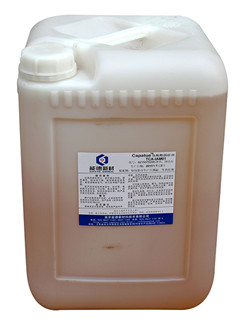

|
Chemical Name: |
Zirconium IV 2,2(bis 2-propenolatomethyl) butanolato, tris 2-methyl-2-propenoato-O |
|
CAS No: |
153590-16-0 |
|
Molecular Structure: |
|
|
Molecular Formula: |
C24H36O9Zr |
Equivalents:
|
Product |
Supplier |
|
NZ-33 |
Kenrich Petrochemicals, Inc |
Typical Properties:
|
Index |
Value |
|
Appearance |
Yellow-orange viscous liquid |
|
Specific Gravity @20℃ |
1.10 |
|
Flash Point, (TCC) |
85℃ |
Abstract:
ZCA-N33 is a neoalkoxy 2-methyl-2-propenoato-O zirconate coupling agent; it has a better thermostability compared to its parallel titanate coupling agent.
The main advantage of zirconates ZCA-N33 is their greater stability; unlike titanates it neither discolor body producers in the presence of phenols (with the exception of nitrophenols), nor do it interact with hindered amines (HALS). In unfilled plastics it also often improves UV stability compared to titanates, and the neoalkoxy variant can provide novel opportunities for coupling fluorinated polymers to metal substrates.
Applications and Performance:
Coupling Agents are molecular bridges at the interface between two substrates, usually but not limited to an inorganic filler/fiber and an organic polymer matrix. Zirconium-derived coupling agents react with free protons at the inorganic interface resulting in the formation of organic-zirconium monomolecular layers on the inorganic surface. Additionally, the coupling agent may have up to Six Functions in the matrix-which include polymer catalysis and other heteroatom effects-independent of inorganic content.
Typically, zircoante-treated inorganics are hydrophobic, organophilic, and organofunctional. Fillers may be pretreated or treated in situ absent water of condensation and drying techniques as needed with silanes. When used in polymers, zircoantes can increase adhesion ;improve impact strength and mechanical properties; reduce embrittlement; allow higher filler loadings; optimize particulate dispersion; increase flow of filled and unfilled polymers at lower process temperatures; prevent phase separation; and may have other effects (see “Suggested Functions”).
Reactive Substrates –Proton reactivity allows coupling to almost all inorganic and organic substrates such as CaCO3, carbonates, carbon black, graphite, minerals, nano-particulates, silicas, silicates, metals, metal oxides, peroxides, hydrates, acetates, borates, sulfates, nitrates, nitramines, aramid, organic pigments, cellulosics, sulfur, azodicarbonamide, polymers, etc.
Suggested Functions-Coupling agent, adhesion promoter, catalyst, repolymerization catalyst, copolymerization catalyst, regrind regenerator, polymer strain and mechanical property improver, dispersion aid, deagglomerator, wetting agent, surfactant, grinding aid , plasticizer or solvent reducer, superplasticizer, low temperature flexibilizer, process aid, peptizer, flow control agent, lubricant, viscosity depressant, thixotrope, suspension aid, impact modifier, comonomer, Lewis Acid reducing agent, hydrophobic agent, cure rate modifier, blowing agent activator, intumescent activator, flame retardant, conductivity enhancer, corrosion inhibitor, anti-aging inhibitor, etc. Function depends on dosage, solubility parameters, dilution, sequencing, process conditions, substrate, polymer, other ingredients, curatives, etc. and their interaction with the isopropoxy, alcoholate, aliphatic and amino chemical functionalities of ZCA-N33.
Potential Applications: ZCA-N33 contains methyl-2-propenoate group which can addition react with the polymer or monomer which have unsaturated bond groups, thus it can used in UV coatings & sealants, unsaturated polyester resin products, peroxide initiated polymer grafting & crosslinking, peroxide cured rubber and co-polymerized with some acrylic, styrene monomer to produce zicornate modified resin.
Packing:
This product is available in 20kg pail, 200L drums and 1000L immediate bulk container.

Storage and Shelf Life:
Should be stored in dry, cool, ventilated room; keep away from water, moisture, high temperature and fire. This product has a shelf life of at least 12 months if stored in tightly closed original container at room temperature.
If this product is kept beyond the shelf life recommend on the product label, it is not necessarily unusable, but a quality control should be performed on the properties relevant to the application.
